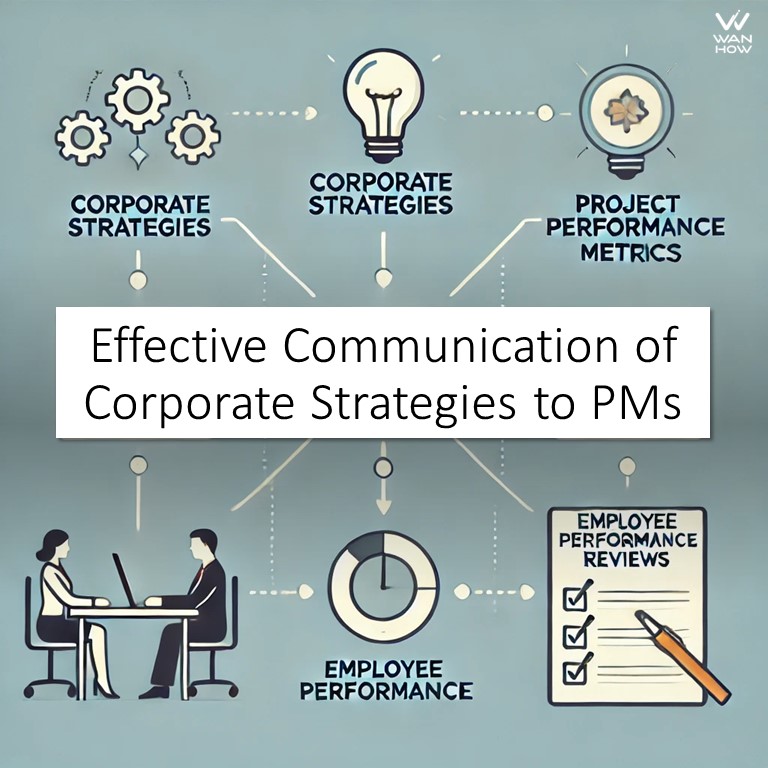
In the fast-paced world of corporate evolution, the ability to adapt to new strategies and policies is paramount. As organizations grow and change, ensuring that project managers (PMs) are well-informed and equipped to implement these changes is crucial for success. However, there is often a disconnect between the strategic vision of senior leadership and the practical realities faced by those delivering the work. This article explores how to bridge this gap and ensure that PMs are educated and have the appropriate tools to meet evolving expectations.
Understanding the Disconnect
Corporate evolution often brings significant changes in strategy, policies, and expectations driven by top-level management. However, this vision can sometimes overlook the practical implications for the PMs responsible for executing the plans.
Common Challenges:
- Lack of Clear Communication: Top-down communication can be vague, leaving PMs without a clear understanding of new expectations.
- Inadequate Training: New policies may require new skills or knowledge, and without proper training, PMs may struggle to adapt.
- Insufficient Tools: Changes in strategy may necessitate new tools or resources that are not readily available to PMs.
- Disconnect Between Vision and Reality: Senior leaders may not fully understand the day-to-day challenges faced by PMs, leading to unrealistic expectations.
Strategies for Effective Communication and Implementation
1. Establish Clear Communication Channels
Effective communication ensures that PMs understand what is expected of them and have the information they need to execute their tasks efficiently.
Two-Way Communication: Encourage open dialogue between senior leaders and PMs to ensure that feedback from the field is considered in strategic planning. Regular town hall meetings where PMs can ask questions and provide input can be invaluable.
Regular Updates: Implement regular updates and briefings to keep PMs informed about changes in strategies and policies. Use multiple channels such as emails, webinars, and face-to-face meetings.
Use of Technology: Leverage technology to enhance communication. Collaboration tools such as Slack, Microsoft Teams, or project management software like Asana or Trello can facilitate real-time communication and ensure that everyone has access to the latest information.
2. Invest in Comprehensive Training Programs
Training is critical to ensuring that PMs have the skills and knowledge needed to implement new strategies effectively.
Tailored Training: Develop training programs that address the new skills and knowledge required by the changes in strategy. If a new software tool is introduced, provide hands-on training sessions to ensure that PMs are comfortable using it.
Continuous Learning: Promote a culture of continuous learning where PMs are encouraged to upskill regularly. Provide access to online courses, workshops, and seminars.
Mentorship Programs: Establish mentorship programs where experienced PMs can guide and support their less experienced colleagues, fostering a culture of collaboration and continuous improvement.
3. Provide the Necessary Tools and Resources
PMs need the right tools and resources to implement new strategies effectively.
Resource Allocation: Ensure that PMs have access to the tools and resources they need to implement new strategies. This may include software, equipment, or additional personnel.
Support Systems: Establish support systems, such as help desks or mentoring programs, to assist PMs in navigating new processes and tools. For instance, a dedicated support team that PMs can reach out to for help with new software can reduce frustration and increase efficiency.
Access to Information: Make sure that PMs have easy access to the information they need. This includes strategic documents, policies, and data and analytics that can help them make informed decisions.
4. Align Strategic Vision with Operational Reality
There is often a gap between the strategic vision of senior leadership and the operational realities faced by PMs. Bridging this gap is essential for successful strategy implementation.
Engage PMs in Strategic Planning: Involve PMs in the strategic planning process to provide insights into the practical implications of proposed changes. Regular workshops where PMs can provide input on strategic initiatives can help ensure that plans are realistic and achievable.
Pilot Programs: Before rolling out major changes, implement pilot programs to test the feasibility and impact on day-to-day operations. Gather feedback and make necessary adjustments. This approach allows for real-world testing and refinement before full implementation.
Realistic Goal Setting: Ensure that the goals set by senior leadership are realistic and achievable. PMs should be involved in the goal-setting process to provide input on what is feasible given current resources and constraints.
5. Foster a Culture of Empathy and Understanding
A culture of empathy and understanding is crucial for bridging the gap between senior leadership and PMs.
Empathetic Leadership: Encourage senior leaders to spend time with PMs and frontline staff to gain a better understanding of their challenges and needs. Regular site visits or shadowing PMs for a day can provide valuable insights.
Recognition and Support: Acknowledge the hard work and contributions of PMs. Provide support and recognition to boost morale and engagement. This can be as simple as a thank-you note or as significant as public recognition at company meetings.
Open Feedback Channels: Establish open channels for feedback where PMs can voice their concerns and suggestions. This can be through anonymous surveys, suggestion boxes, or regular feedback sessions with senior leaders.
6. Integrate Corporate Strategies into Performance Reviews
Corporate strategies and policies can be effectively communicated through annual, semi-annual, and quarterly employee performance reviews. Strategies and policies should be distilled into clear business goals, expressed in measurable project performance metrics. PMs can then report on these metrics that align with corporate strategies and policies, and their personal performance reviews can be tied to the delivery of these metrics.
Clear Business Goals: Ensure that corporate strategies and policies are broken down into specific, actionable business goals. These should be communicated clearly to PMs during performance reviews.
Measurable Metrics: Establish measurable project performance metrics that align with corporate strategies and policies. PMs should understand how their work contributes to these metrics and what success looks like.
Regular Reviews: Conduct regular performance reviews to track progress against these metrics. This keeps PMs focused on the goals and provides an opportunity to address any challenges or barriers.
Support from Business Analysts: PMs may need support from business analysts to track these metrics effectively. This is a matter of resource management and capacity planning. Ensure that PMs have access to the necessary analytical support to succeed.
Alignment with Strategy: As corporate strategies and policies change, ensure that new metrics are established to reflect these changes. This keeps PMs aligned with the latest strategic priorities.
Conclusion
Ensuring that corporate strategies and policies are communicated effectively to PMs is critical for successful implementation. By establishing clear communication channels, investing in training, providing necessary tools, aligning vision with reality, fostering a culture of empathy, and integrating strategies into performance reviews, organizations can bridge the gap between senior leadership and project managers. This not only enhances the effectiveness of strategy implementation but also empowers PMs to deliver their best work, driving the organization toward its goals.
In an era of constant corporate evolution, let’s commit to supporting our PMs with the clarity, training, and resources they need to thrive. After all, they are the ones turning strategic visions into operational successes.
Related Post: Conflicting Corporate Priorities: A Project Manager’s Guide to Streamlining Projects
